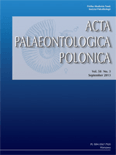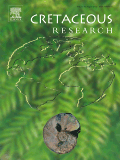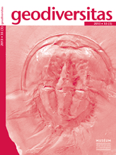
REVISTA BRASILEIRA DE PALEONTOLOGIA
Scope & Guideline
Connecting Scholars to the Rich Tapestry of Earth's History
Introduction
Aims and Scopes
- Paleontological Research and Documentation:
The journal publishes extensive studies on fossil organisms, focusing on their identification, classification, and the implications of these findings for understanding biodiversity and evolutionary processes. - Biostratigraphy and Paleoecology:
Articles often investigate the stratigraphic distribution of fossils and reconstruct ancient environments, contributing to a deeper understanding of ecological dynamics through geological time. - Taphonomy and Fossil Preservation:
Research on the processes affecting fossilization, preservation conditions, and the interpretation of fossil assemblages is a critical component of the journal, enhancing knowledge of how fossils inform us about past life. - Regional Paleontology:
A significant emphasis is placed on the paleontological record of Brazil and surrounding regions, documenting local fossil discoveries and their broader implications for global paleontological knowledge. - Interdisciplinary Approaches:
The journal encourages interdisciplinary research that integrates paleontology with other scientific fields, such as geology, biology, and environmental science, to provide holistic insights into past life forms.
Trending and Emerging
- Quaternary Paleontology:
There is a rising interest in Quaternary fossils, particularly those from Brazil, reflecting a broader trend in understanding recent evolutionary changes and their ecological implications. - Taphonomic Studies:
Research examining the processes of fossilization and the environmental conditions affecting fossil preservation is gaining traction, indicating an increased focus on the significance of taphonomy in paleontological research. - Phylogenetic Analyses:
Emerging studies are increasingly utilizing phylogenetic methods to understand the evolutionary relationships among taxa, particularly in vertebrate paleontology, showcasing a modern approach to classification and evolutionary biology. - Microbial Paleontology:
The exploration of microbial components within fossil records is becoming a notable trend, emphasizing the role of microorganisms in ancient ecosystems and their fossilization processes. - Paleoenvironmental Reconstruction:
There is a growing emphasis on reconstructing ancient environments through detailed analyses of fossil assemblages, sedimentology, and isotopic studies, indicating a shift towards understanding ecological dynamics in historical contexts.
Declining or Waning
- Micropaleontology:
There has been a noticeable decrease in publications focusing on micropaleontological studies, such as those involving foraminifera and nannofossils, which previously constituted a significant portion of the journal's output. - Paleoclimatology:
Research articles centered on paleoclimatic reconstructions and their implications for climate change have become less frequent, indicating a potential shift in research priorities within the journal. - Invertebrate Paleontology:
The representation of studies specifically targeting invertebrate fossils, such as corals and mollusks, has diminished, suggesting a move towards vertebrate paleontology and other areas of focus. - Geological Correlation Studies:
The frequency of studies aimed at geological correlation across different regions and formations has waned, possibly reflecting a more localized focus on Brazilian paleontological contexts. - Educational Aspects of Paleontology:
While the journal has previously included articles on the role of paleontology in education, this theme appears to be less prominent in recent issues, indicating a shift towards more research-intensive articles.
Similar Journals

FACIES
Fostering Innovation in the Study of Earth’s Past and PresentFACIES is a prominent academic journal published by Springer, dedicated to advancing knowledge in the fields of Geology, Paleontology, and Stratigraphy. With its rich history since 1979 and an impactful convergence of research efforts extending through 2024, FACIES has established itself as a vital resource for scholars and practitioners. The journal boasts impressive ranking metrics: it is positioned in Q2 within Geology and Stratigraphy, and Q1 in Paleontology, reflecting its high-quality contributions to the academic community. Furthermore, its notable Scopus ranks—#28 in Paleontology, #16 in Stratigraphy, and #91 in Geology—underscore its influence and relevance. Although not an open-access journal, FACIES continues to provide significant findings that inform geological practices and enrich our understanding of past and present Earth systems. It serves as an essential platform for innovative research, making it invaluable for researchers, professionals, and students who seek to impact the fields of Earth sciences.

PALAEONTOGRAPHICA ABTEILUNG A-PALAOZOOLOGIE-STRATIGRAPHIE
Innovative Perspectives: Bridging Paleontology and StratigraphyPalaeontographica Abteilung A-Palaozoologie-Stratigraphie is a prominent academic journal that serves as a vital resource for researchers in the fields of Paleontology and Stratigraphy. Published by E Schweizerbart'sche Verlagsbuchhandlung in Germany, this journal has been instrumental in disseminating cutting-edge research from 1996 to 2024. With an established reputation highlighted by its Q3 ranking in both Paleontology and Stratigraphy, it ranks 26th among 113 journals in Paleontology and 15th among 55 in Stratigraphy, showcasing its significance within the scientific community. Although it does not currently offer open access, the journal provides an invaluable platform for the exchange of innovative ideas and findings in paleobiological and stratigraphic studies. As such, Palaeontographica continues to attract contributions from leading academics, making it an indispensable publication for professionals and students alike who are eager to advance their understanding of Earth's historical biological and geological patterns.

ACTA PALAEONTOLOGICA POLONICA
Connecting Researchers to Earth's Evolutionary StoryACTA PALAEONTOLOGICA POLONICA is a leading scholarly journal in the field of paleontology, published by the Institute of Paleobiology, Polish Academy of Sciences. With its open access model established since 1956, the journal ensures that vital research related to Earth's history and the evolution of life is freely accessible to a global audience. Based in Warsaw, Poland, this journal has garnered a respectable impact within the academic community, currently positioned in the Q2 quartile of its field and ranking #47 out of 113 in Scopus for Earth and Planetary Sciences, reflecting its significance in advancing paleontological research. Covering a wide range of topics related to fossil studies and evolutionary biology, ACTA PALAEONTOLOGICA POLONICA serves as a crucial platform for researchers, professionals, and students alike, encouraging the dissemination of innovative ideas and discussions that contribute to our understanding of past life on Earth. As it continues to publish high-quality articles through to 2024 and beyond, this journal remains integral to the ongoing discourse in paleontological sciences.

Fossil Record
Uncovering the Past, Shaping the Future of PaleontologyFossil Record is a prestigious open access journal pioneering the field of paleontology, published by Pensoft Publishers in Germany. Since its inception in 1998, it has provided a vital platform for the dissemination of groundbreaking research that advances our understanding of ancient life and environmental change through time. Holding an impressive Q2 quartile ranking in the field and securing a notable position among the top 73rd percentile of paleontological journals, Fossil Record ranks #31 out of 113 in the Scopus classification of Earth and Planetary Sciences. With a commitment to quality and accessibility, the journal not only encourages critical dialogue among researchers, professionals, and students but also promotes the sharing of knowledge worldwide. Explore its comprehensive repository of articles to stay abreast of the latest findings that shape our understanding of the planet’s history.

Stratigraphy
Advancing the Science of Earth's LayersStratigraphy is a distinguished journal dedicated to advancing the field of paleontology and stratigraphic research. Published by MICRO PRESS in the United States, this journal is accessible via its ISSN 1547-139X and E-ISSN 2331-656X, providing an essential platform for researchers, professionals, and students alike. With a robust focus on the intricate relationships between geological time and the fossil record, Stratigraphy aims to disseminate high-quality research that enhances our understanding of Earth’s history. Its ranking within the 2023 Q2 category of paleontology reflects its commitment to scholarly excellence, as noted by a Scopus ranking of #65 out of 113 in the Earth and Planetary Sciences domain, placing it in the 42nd percentile. Although not open access, the journal's valuable contributions from 1988 to 2024 encourage a collaborative dialogue among the scientific community, underscoring the significance of stratigraphic studies in environmental and evolutionary research.

PALAEONTOLOGIA ELECTRONICA
Connecting Researchers to the Rich Tapestry of Earth's HistoryPALAEONTOLOGIA ELECTRONICA is a distinguished open-access journal published by COQUINA PRESS, offering a vital platform for the dissemination of cutting-edge research in the fields of Paleontology and Oceanography. Launched in 1998, this journal has continuously fostered scholarly communication, allowing unrestricted access to scientific findings and contributing significantly to the advancement of the field. With an impressive track record since its inception, PALAEONTOLOGIA ELECTRONICA holds a 2023 Scopus ranking of #39 out of 113 in the Paleontology category, demonstrating its value among academic resources as evidenced by its Q2 quartile ranking. The journal is based in the United States, and it encourages submissions that span a diverse range of topics, from fossil analysis to evolutionary biology. As a prominent resource for researchers, educators, and students alike, it plays a crucial role in shaping the future of paleontological study.

STRATIGRAPHY AND GEOLOGICAL CORRELATION
Pioneering Research in Earth Sciences and Stratigraphic StudiesSTRATIGRAPHY AND GEOLOGICAL CORRELATION is a prominent scholarly journal published by PLEIADES PUBLISHING INC, featuring a dedicated focus on the fields of geology, stratigraphy, and paleontology. With ISSN 0869-5938 and E-ISSN 1555-6263, this journal has been disseminating significant research findings since its inception in 1994, continuously contributing to the academic discourse through 2024. Despite not currently offering open access, its relevance is underscored by its Category Quartiles for 2023, where it has established itself as Q3 in Geology and Paleontology, and Q2 in Stratigraphy. STRATIGRAPHY AND GEOLOGICAL CORRELATION ranks #29 out of 55 in Stratigraphy and #186 out of 321 in Geology according to Scopus metrics, positioning it within the competitive landscape of Earth and Planetary Sciences. Researchers, professionals, and students are invited to engage with the journal’s content to deepen their understanding and foster innovation within these critical areas of study.

CRETACEOUS RESEARCH
Advancing Knowledge of Prehistoric LifeCRETACEOUS RESEARCH, published by Academic Press Ltd - Elsevier Science Ltd, is a leading journal in the field of Paleontology that has established itself as an essential resource for researchers and professionals delving into the rich tapestry of the Cretaceous period. With its ISSN 0195-6671 and E-ISSN 1095-998X, this journal boasts a prestigious placement in the academic landscape, holding a Q1 rank in the 2023 Paleontology category and proudly positioned at 21st out of 113 in the Scopus ranking, reflecting its impact factor that places it in the 81st percentile. Since its inception in 1980, CRETACEOUS RESEARCH has facilitated a deeper understanding of prehistoric life and its evolutionary processes, covering topics such as fossil discoveries, paleoecology, and biostratigraphy. This journal best serves those seeking to expand their knowledge and contribute innovative findings to the scientific discourse surrounding the Cretaceous era. As it continues to converge into the future until 2025, it remains dedicated to providing an open platform for the dissemination of high-quality research that shapes our understanding of Earth’s geological past.

RIVISTA ITALIANA DI PALEONTOLOGIA E STRATIGRAFIA
Connecting Past and Present through GeologyRIVISTA ITALIANA DI PALEONTOLOGIA E STRATIGRAFIA, published by Università degli Studi di Milano, is a leading open access journal dedicated to the fields of Paleontology, Geology, and Stratigraphy. Established in 1979, this prestigious journal fosters the dissemination of high-quality research and innovative studies within these disciplines, holding a commendable Q2 ranking in Geology, Paleontology, and Stratigraphy as of 2023. The journal’s commitment to accessibility since 2016 underlines its objective to promote the sharing of knowledge among researchers, professionals, and students alike. With its notable Scopus rankings reflecting a solid performance in the Earth and Planetary Sciences, particularly in Paleontology and Stratigraphy, RIVISTA ITALIANA serves as a vital resource for those seeking to stay informed on the latest advancements and discoveries within the geological sciences. For further inquiries, the editorial office is located at C/O RIVISTA ITALIANA PALEONTOLOGIA STRATIGRAFIA, VIA MANGIAGALLI, 34, 20133 MILANO, ITALY.

GEODIVERSITAS
Fostering Innovation in Earth SciencesGEODIVERSITAS, an esteemed journal published by the Museum National d'Histoire Naturelle, represents a significant contribution to the fields of geology and paleontology. With an ISSN of 1280-9659, this peer-reviewed publication has established itself as a vital resource for researchers, professionals, and students alike, disseminating high-quality and innovative research since its inception in 2002. Covering a broad spectrum of topics within earth sciences, GEODIVERSITAS not only showcases cutting-edge studies but also fosters a deeper understanding of geological and paleontological phenomena. Ranked in the Q2 category of both geology and paleontology for 2023, the journal exemplifies rigorous scholarly standards and makes significant strides in enhancing knowledge within these disciplines. With its headquarters in Paris and a commitment to scientific excellence, GEODIVERSITAS stands as a leading voice in contemporary earth science research, inviting contributions that drive forward the conversation in geology and paleontology.